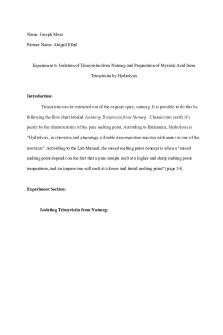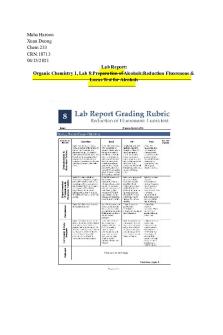Post Lab Report 10 PDF

| Title | Post Lab Report 10 |
|---|---|
| Author | Abigail Finch |
| Course | Organic Chemistry Laboratory II |
| Institution | University of South Florida |
| Pages | 8 |
| File Size | 381 KB |
| File Type | |
| Total Downloads | 61 |
| Total Views | 155 |
Summary
lab report...
Description
Experiment 10: Wittig Reaction- Synthesis of trans-9-(2-phenylethenyl)anthracene Introduction Background The Wittig reaction involves the use of a carbonyl compound- either a ketone or aldehyde, and a phosphonium ylide. The carbonyl acts as an electrophile while the phosphonium ylide is the nucleophile that attacks. The first step of the mechanism is the generation of the wittig reagent by treatment of a phosphonium salt with a strong base. The Wittig reaction is extremely valuable as a means of alkene synthesis and the formation of new carbon-carbon bonds. An example of an intramolecular Wittig reaction is seen when 1-bromo-6-heptanone is reacted with PPh3 and n-BuLi to form 1-methylcyclohex-1-ene and Ph3P=O. A related concept is the Horner-Wadsworth-Emmons modification. This modification is used in organic chemistry to produce E-alkenes as the predominant product. This method uses phosphonate-stabilized carbanions, which are more nucleophilic than phosphonium ylides. An example of this modification is the use of Trimethylsilyl Methyl-phosphonate, LIHMDS, and THF to produce the desired E alkene. Figure 1: Mechanism of Reaction
Figure 2: Possible Side Reactions
Experimental Section Table 1: Flow Chart Summary of the Experiment Wittig Reaction Procedure Experimental…
Reaction mixture...
Recrystallization...
Product analysis...
+5 mL conical vial +300 mg benzyltriphenylphosp honium chloride +115 mg 9-anthraldehyde +1 mL dichloromethane +magnetic stir bar +TLC +.4 mL NaOH & rapid stirring +stir for 30 min +TLC complete rxn
+1.5 mL DCM +1.5 mL H2O +cap & shake +drain organic layer +1.5 mL DCM +cap & shake +drain & combine organic layer +CaCl2 +decant solution +remove DCM
+3 mL 1-propanol +heat solution +cool rxn to RT +cool rxn to 0 +collect by Hirsch
+obtain mass +calculate percent yield +determine melting point +obtain IR -lose peak 1710 -gain peak 1640 +obtain H NMR +obtain C NMR +complete questions
Experimental Procedure -Add 300 mg benzyltriphenylphosphonium chloride, 115 mg 9-anthraldehyde, and 1 mL dichloromethane to a conical vial. Take initial TLC. Rapidly stir with the magnetic stir rod and add .4 mL sodium hydroxide with a pasteur pipette. Stir for 30 min. Take a second TLC. Add 1.5 mL dichloromethane and 1.5 mL water; cap and shake vial.
-Remove the organic layer into a reaction tube and extract the aqueous with 1 mL dichloromethane. Dry with calcium chloride pellets. Wash with a solvent and vacuum filter. Add 3 mL 1-propanol to the solid remaining in the flask, heat and transfer to the Erlenmeyer flask. Cool to room temperature, cool in ice, and collect product with a Hirsch funnel. Obtain mass, percent yield, melting point, IR and H-NMR spectra. Table of Chemicals Table 2: Analysis of the Chemicals in the Experiment Name
Sodium hydroxide
dichloromet 1-propanol hane
9-anthraldeh yde
Benzyltriphe nylphosphon ium chloride
Formula
NaOH
CH2Cl2
C3H8O
C15H10O
C25H22ClP
Molar mass (g/mol)
39.997
84.93
60.095
206.24
388.9
Boiling point (°C)
1388
39.6
97
405.7
N/A
Melting point (°C)
318
-96.7
-126
104
332
-may be corrosive to metals -skin corrosion, irritation -serious eye damage, irritation
-carcinogeni city -skin irritant, corrosive -serious eye damage, irritation -specific organ toxicity -targets CNS, liver,
-highly flammable liquid and vapor -causes serious eye damage -may cause drowsiness or dizziness
-not considered hazardous
-fatal if swallowed -toxic in contact with skin -causes serious eye damage -fatal if inhaled -respiratory tract irritation
Structure
Hazards
kidneys, blood
Results Table 3: Results from the Experiment Physical properties
trans-9-(2-phenylethenyl)anthracene
Melting point
128-131 °C
Weight
250 mg
Rf
.90
Calculations Percent yield =
𝑎𝑐𝑡𝑢𝑎𝑙 𝑣𝑎𝑙𝑢𝑒 x 𝑡ℎ𝑒𝑜𝑟𝑒𝑡𝑖𝑐𝑎𝑙 𝑣𝑎𝑙𝑢𝑒
Actual value: 0.250 g
100%
Theoretical value: 0.157 g
Percent yield =
.157𝑔 x .250𝑔
100% = 62.8%
Moles 9-anthraldehyde = moles trans-9-(2-phenylethenyl)anthracene 0.115 g 9-anthraldehyde x
1 𝑚𝑜𝑙 9−𝑎𝑛𝑡ℎ𝑟𝑎𝑙𝑑𝑒ℎ𝑦𝑑𝑒 206.24 𝑔/𝑚𝑜𝑙
= .00056 mol 9-anthraldehyde
.00056 mol trans-9-(2-phenylethenyl)anthracene x g
Rf value =
280.36 𝑔/𝑚𝑜𝑙 1 𝑚𝑜𝑙 𝑡𝑟𝑎𝑛𝑠−9−(2−𝑝ℎ𝑒𝑛𝑦𝑙𝑒𝑡ℎ𝑒𝑛𝑦𝑙)𝑎𝑛𝑡ℎ𝑟𝑎𝑐𝑒𝑛𝑒
= .157
𝑑𝑖𝑠𝑡𝑎𝑛𝑐𝑒 𝑡𝑟𝑎𝑣𝑒𝑙𝑙𝑒𝑑 𝑏𝑦 𝑚𝑜𝑙𝑒𝑐𝑢𝑙𝑒 𝑑𝑖𝑠𝑡𝑎𝑛𝑐𝑒 𝑡𝑟𝑎𝑣𝑒𝑙𝑙𝑒𝑑 𝑏𝑦 𝑠𝑜𝑙𝑣𝑒𝑛𝑡
Distance travelled by the solvent: 4.1 cm Distance travelled by the 9-anthraldehyde: 2.8 cm Distance travelled by the product (trans-9-(2-phenylethenyl)anthracene): 3.7 cm 2.8 𝑐𝑚
9-anthraldehyde = 4.1 𝑐𝑚 = 0.68
0.90
Spectroscopy
product
(trans-9-(2-phenylethenyl)anthracene)=
3.7 𝑐𝑚 = 4.1 𝑐𝑚
Figure 1: Experimental IR Spectrum for trans-9-(2-phenylethenyl)anthracene
Figure 2: Experimental H-NMR Spectrum for trans-9-(2-phenylethenyl)anthracene
Figure 3: Theoretical H-NMR Spectrum for trans-9-(2-phenylethenyl)anthracene
Discussion The literature value for the melting point of trans-9-(2-phenylethenyl)anthracene is 130-132 °C; the experimental value was measured to be 128-131 °C. This value indicates a small level of impurity in the final product but overall supports the appearance of the desired product. The TLC for this reaction confirmed the appearance of the desired product. The Rf value for 9-anthraldehyde was calculated to be .68, while the product had an Rf of .90. This confirms the reaction progression as we would have expected the product to travel more distance as it is less polar due to the loss of the C=O bond. The product was determined to be .250 g, with the theoretical yield being .157 g. With this information, the percent yield was calculated to be 62.8%; this indicates that the reaction was pretty efficient but also saw some error. The results of the melting point and Rf tests support that the desired product was attained, but most likely saw significant product loss in the recrystallization step, owing to the lower percent yield. The IR spectra for the product also supports the appearance of the desired product. The major factor to look for in this experiment would be the absence of a peak around 1710 in the product’s
spectrum. The peak at 1710 relates to the carbonyl functional group and should be hence absent in the final product. The experimental spectrum in this case showed no peak at 1710 and only small peaks around 3100 for the sp2 hybridized C-H bonds. The H-NMR spectrum also helped identify the product because of the great similarities between the theoretical and experimental spectra. In both spectra, one distinct region around 6-9 ppm contains all the peaks. The lowest peak should represent the two protons of the alkene bond, while 9 other distinct proton signals are located between the phenyl and anthracene rings. The protons on carbons closer to the alkene will be higher in H-NMR value. Together, the IR, H-NMR, and TLC support the appearance of the desired product, acetylsalicylic acid. Conclusion In this experiment, trans-9-(2-phenylethenyl)anthracene was successfully synthesized. The data including the percent yield, melting point, TLC, IR spectrum and H NMR spectrum of the product all supported a successful synthesis of the desired product. With that being said, the percent yield suggested the loss of product perhaps attributable to the recrystallization step. The IR and H NMR spectra also supported the product designation by displaying the predicted peaks for trans-9-(2-phenylethenyl)anthracene and not displaying the peaks associated with 9-anthraldehyde. The techniques performed in this lab could be utilized in various other fields when the addition of carbon carbon bonds is needed, such as in the production of synthetic polymers or biomolecules. Overall, the lab succeeded in its goal to perform the Wittig reaction and produce trans-9-(2-phenylethenyl)anthracene. References Schaller, Chris. “Wittig Reactions.” Chemistry LibreTexts. Libretexts, June 5, 2019.
Solomon, and Weldegirma. “Experiment 10: Wittig Reaction- Synthesis of trans-9-(2-phenylethenyl)anthracene.” Experimental Organic Chemistry, Laboratory Manual, 9 ed, (2020). J.R. Mohrig, C.N. Hammond and P.F. Schatz, Techniques in Organic Chemistry, Freeman Publishers, 2nd Edition....
Similar Free PDFs

Post Lab Report 10
- 8 Pages

Post Lab report 10 Wittig
- 10 Pages

Post lab 10 - Post lab 10
- 3 Pages

Post Lab - lab report
- 2 Pages

Experiment 10 Post-Lab
- 12 Pages

Post Lab Report 7
- 8 Pages

Post lab report 4
- 12 Pages

Post Lab Report Lab 5
- 5 Pages

Lab 10 - Lab 10 Report
- 7 Pages

Experiment 4 Post-Lab Report
- 8 Pages

Experiment 8 Post-Lab Report
- 15 Pages

LAB Report 2 - Post Lab Question
- 2 Pages

SCC 202-Lab#2-Post Lab Report
- 9 Pages

Orgo Post-lab 8 - Orgo- Lab report
- 14 Pages
Popular Institutions
- Tinajero National High School - Annex
- Politeknik Caltex Riau
- Yokohama City University
- SGT University
- University of Al-Qadisiyah
- Divine Word College of Vigan
- Techniek College Rotterdam
- Universidade de Santiago
- Universiti Teknologi MARA Cawangan Johor Kampus Pasir Gudang
- Poltekkes Kemenkes Yogyakarta
- Baguio City National High School
- Colegio san marcos
- preparatoria uno
- Centro de Bachillerato Tecnológico Industrial y de Servicios No. 107
- Dalian Maritime University
- Quang Trung Secondary School
- Colegio Tecnológico en Informática
- Corporación Regional de Educación Superior
- Grupo CEDVA
- Dar Al Uloom University
- Centro de Estudios Preuniversitarios de la Universidad Nacional de Ingeniería
- 上智大学
- Aakash International School, Nuna Majara
- San Felipe Neri Catholic School
- Kang Chiao International School - New Taipei City
- Misamis Occidental National High School
- Institución Educativa Escuela Normal Juan Ladrilleros
- Kolehiyo ng Pantukan
- Batanes State College
- Instituto Continental
- Sekolah Menengah Kejuruan Kesehatan Kaltara (Tarakan)
- Colegio de La Inmaculada Concepcion - Cebu

